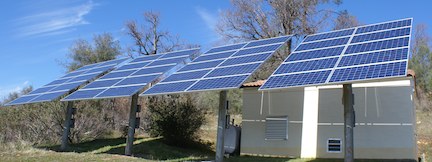A 100W panel will only produce about 5A if connected to a 12V battery. So 5A x 4 panels is about 20A.
If you check the nameplate of the panel, it'll tell you that the voltage and current at maximum power (100W) is roughly 18V and 5A. It'll also tell you that the short circuit current (Isc) will be around 5.5A, which gives you a rough idea of the maximum current the panel can possibly produce.
If the panel is connected to a battery directly or through a PWM controller, the panel voltage will be "pulled down" to about 12V and the current will be about 5A, or roughly 60W. What this means is that, with a PWM controller that really just operates as an on/off switch to the battery, the panel is really a 60W panel, not 100W. To get 100W out of it you'd need to use an MPPT controller and wire them in series. An MPPT controller allows the panels to "sit" at whatever voltage creates the most power, in this case about 18V/panel.
If you check the nameplate of the panel, it'll tell you that the voltage and current at maximum power (100W) is roughly 18V and 5A. It'll also tell you that the short circuit current (Isc) will be around 5.5A, which gives you a rough idea of the maximum current the panel can possibly produce.
If the panel is connected to a battery directly or through a PWM controller, the panel voltage will be "pulled down" to about 12V and the current will be about 5A, or roughly 60W. What this means is that, with a PWM controller that really just operates as an on/off switch to the battery, the panel is really a 60W panel, not 100W. To get 100W out of it you'd need to use an MPPT controller and wire them in series. An MPPT controller allows the panels to "sit" at whatever voltage creates the most power, in this case about 18V/panel.


Comment